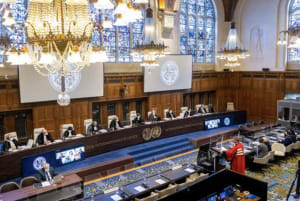Thinking about the Roman Empire? In Israel, one keeps stumbling over it
The Roman 10th Legion ‘Fretensis’ left mementos all over Jerusalem

In recent weeks, another TikTok trend has swept the world to the degree that even traditional media outlets have begun to cover it.
“How often do you think about the Roman Empire?”
This question is being posed by girlfriends and wives, who are shocked when the answer, more often than not, is “daily” or at least “once a week.”
The trend began in the United States, making the answers all the more surprising. Here in Israel, there are, of course, daily reminders of the empire that ruled this region for hundreds of years.
Jerusalem has no huge Roman structure, such as an amphitheater or a bathhouse. But if you know where to look, you’ll find clues about the Romans everywhere.
Most people who visit Jerusalem’s Old City for the first time will enter through the Jaffa Gate, which wasn’t constructed by the Romans but by the Ottoman Turks. However, just before the entrance to the gate, one of the stones in the wall provides a glimpse into the past.
If you look closely, you can see a stone with the inscription X ET. These mysterious letters are what is left of the original inscription LEG X FRET, pointing to the Roman Tenth Legion, Legio X. Fretensis.

Reminders of this legion, which garrisoned the Holy Land over hundreds of years, can be found in the most surprising places.
The Tenth Legion first came to the land of Israel as part of the Roman army led by emperor Vespasian, and later by his son Titus, to crush the Great Jewish Revolt (66–73 A.D.), the results of which can still be seen by visiting the ruins of Gamla in the Golan Heights, Herodion near Jerusalem and Masada near the Dead Sea, all sites that fell prey to the Tenth Legion.
But Legio Fretensis left more subtle marks. Roman legions were well known for their building activities in times of peace, and the Tenth was very active in that regard.
It manufactured stones, bricks, pottery and roof tiles that were inscribed or stamped with the legion’s name and at times with one of its symbols, either a boar or a ship. These items were often reused in later centuries, thus ending up on the 16th-century city wall.
Another famous reminder of the legion can be found after entering the gate and then taking a left turn into the courtyard of the Imperial Hotel.
If you take a closer look at what seems to be just another lamp post, you will find that its base is actually a milestone erected by the Tenth Legion sometime around 200 A.D. In the inscription that honors the legion’s legate Marcus Junis Maximus, one can make out the letters 'LEG X FR.'

Other such stones can be found in situ throughout the city and the surrounding area, for example in the wall of the Crusader-era church in the Arab village of Abu Ghosh, while numerous examples made their way into The Israel Museum in Jerusalem.
In this way, the Roman Empire continues to be present throughout Israel’s landscape and in the minds of its residents, even without the need for silly TikTok trends.
We recommend to read:

Hanan Lischinsky has a Master’s degree in Middle East & Israel studies from Heidelberg University in Germany, where he spent part of his childhood and youth. He finished High School in Jerusalem and served in the IDF’s Intelligence Corps. Hanan and his wife live near Jerusalem, and he joined ALL ISRAEL NEWS in August 2022.








